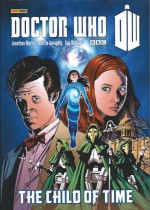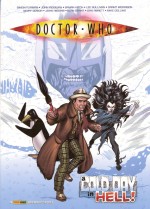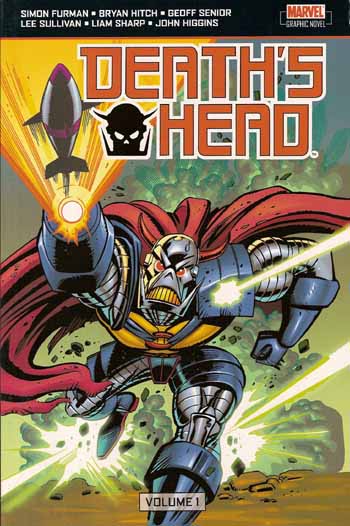
By Jonathan Morris, Mike Collins, David A. Roach, Roger Langridge, Martin Geraghty, Dan McDaid, Rob Davis, Geraint Ford, Adrian Salmon, & James Offredi (Panini Books)
ISBN: 978-1-84653-460-7
Win’s Christmas Gift Recommendation: scintillating, superior sci fi for the bigger kids cluttering up the house and waiting for the TV Specials to start … 8/10
Doctor Who launched on television in the first episode of ‘An Unearthly Child’ on November 23rd 1963. Less than a year later, his decades-long run in TV Comic began with issue #674 and the premier instalment of ‘The Klepton Parasites’. On 11th October 1979 (although adhering to the US off-sale cover-dating system so it says 17th) Marvel’s UK subsidiary launched Doctor Who Weekly, which became a monthly magazine in September 1980 (#44) and has been with us under various names ever since.
All of which only goes to prove that the Time Lord is a comic hero with an impressive pedigree…
Panini is in the ongoing process of collecting every strip from its archive in a uniform series of over-sized graphic albums, each concentrating on a particular incarnation of the deathless wanderer. This particular one gathers stories short and long which, taken together comprise a two-year extended epic. From Doctor Who Magazine (or DWM) #421-441 (originally published between 2010-2011), this run features the strip debut of the Matt Smith incarnation of the far-flung, far-out Time Lord as well as his foremost companion Amy Pond.
None of which is relevant if all you want is a darn good read. All the creators involved have managed the ultimate task of any comics-creator – to produce engaging, thrilling, fun stories which can be equally enjoyed by the merest beginner and the most slavishly dedicated – and opinionated – fans imaginable.
With all tales written by Jonathan Morris (plus, according to the author, liberal input from editors Scott Gray & Tom Spilsbury), coloured by James Offredi and lettered by Roger Langridge, the drama kicks off in ‘Supernature’ (illustrated by Mike Collins & David A. Roach, from DWM #421-423, May-July 2010).
Arriving on a jungle paradise world The Doctor and Amy quickly discover Earthling colonists in the midst of a terrifying plague…
The humans – all convicts press-ganged and abandoned to turn the planet into a suitable home – are being transformed into uncanny mutant beasts, and even the Time Lord and his new companion are monsterised before the crisis is solved. However when they depart they take part of the problem with them…
A rare but very welcome art job for regular letterer Langridge results in a bizarre and wonderful spoof on ‘Planet Bollywood!’ when warring factions of an ancient empire – and a romantic leading man – all struggle to possess a sexy humanoid device which compels listeners to break out in song and dance routines, after which a trip to Tokyo found fresh horror in the metamorphosis of innocent – if educationally lacking – children into a deadly fifth column…
‘The Golden Ones’ (#425-428, by Martin Geraghty & Roach) is a grand old-fashioned blockbuster invasion saga with a huge body-count, valiant armed resistance by dedicated UNIT soldiers, a classic villain’s return, a brilliant scientific solution and a slew of subtle clues to the greater saga unfolding. Just who is that strange little girl who keeps popping up everywhen?
From #429 comes the literary fantasy-homage ‘The Professor, the Queen and the Bookshop’ (Rob Davis & Geraint Ford) wherein our heroes meet a reclusive writer and evacuee children Amy – and hubby-to-be Rory – encounter a strange man in an infinite shop which can travel anywhere…
It’s back to Paris in 1858 for Dan McDaid’s ‘The Screams of Death’ as aspiring but hopeless singer Cosette is taken under the wing of impresario Monsieur Valdemar and develops a voice that could shake the Opera House to its foundations. Of course, the Svengali-like Fugitive from the Future had far grander plans for his many captive songbirds until Mam’selle Pond and M’sieu le Docteur turned up to foil a mad scheme to rewrite history…
The over-arching epic takes a big step forward in #432’s ‘Do Not Go Gentle into that Good Night’ (featuring a welcome full-art outing for the splendid David Roach) as the Tardis turns up in an old people’s home staffed by robots, haunted by children and plagued by a vanishing roster of residents, whilst Adrian Salmon gets his freak on in the trippy terror-tale ‘Forever Dreaming’ (#433-434) as Amy is apparently trapped in a 1960’s seaside town with a dark secret, a phantom octopus and a host of psychedelic icons who really should be dead…
The saga swings into full acceleration with ‘Apotheosis’ (DWM #435-437 and limned by McDaid) as the Doctor and Amy land aboard a derelict space station and walk into the closing act of a galaxy-spanning war between humanity and their scheduled replacements: the awesome autonomous androids of Galatea.
Aboard the station, a cadre of warrior Space Nuns are seeking an ultimate weapon to tip the scales of the conflict, but with lethal sanitation robots everywhere and rogue time-distortion fields making each step a potential death-march, the hunt is hard-going. With everybody – even the Time Lord – hyper-aging at vastly different rates, when the Tardis then mutates into something impossible, the stage is set for a spectacular threat to all of creation to be born…
Of course, first the Machiavellian, monstrously manipulative and atrociously amoral creature calling herself Chiyoko must carry out a number of crucial appointments in Eternity to ensure the existence and consolidate the celestial dominance of ‘The Child of Time’ (with art from Geraghty & Roach from (DWM #438-441 August -November 2011).
Two years’ worth of cleverly-concocted mystery and imagination are then wrapped up in a staggering, creatively-anachronistic display of temporal hocus-pocus by scripter Morris as The Doctor, Amy and allies Alan Turing and the Bronte Sisters ward off the unmaking of time, the end of humanity and eradication of all life in the universe before the tragic finale and a happy ever after of sorts…
Dedicated fans can also enjoy a treasure-trove of background information in the 25-page text Commentary section at the back, comprising chapter-by-chapter background, history and insights from the author and each of the illustrators, supplemented by happy horde of sketches, roughs, designs, production art and even excised material from all concerned.
We’ve all have our private joys and hidden passions. Sometimes they overlap and magic is made. This is another superb set of supremely satisfying comic strips, starring an absolute Pillar of the British Fantasy pantheon.
If you’re a fan of only one, The Child of Time should certainly spark your hunger for the other. This is a fabulous book for casual readers, a fine shelf addition for devotees of the show, the ideal opportunity to cross-promote our particular art-form and the perfect present for the Telly Addict haunting your house…
All Doctor Who material © BBCtv. Doctor Who logo © BBC 2012. Tardis image © BBC 1963. Doctor Who, Tardis and all logos are trade marks of the British Broadcasting Corporation and are used under licence by BBC Worldwide. Published 2012 by Panini Publishing, Ltd. All rights reserved.



